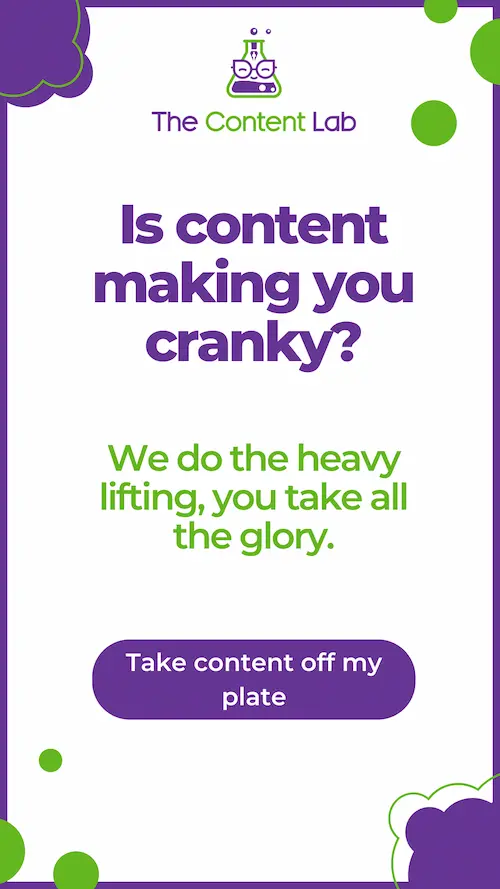Web design is an awesome career choice.
On a personal level, it gives you an outlet for your creativity while lending itself to remote working (if the notion takes you to travel the world while still bringing in that cash money dolla billz).
Professionally, it’s a relatively stable creative field to enter because people always need websites.
When times are good, people have money to spend on refreshing their brand. When times are not so good, people often need to invest in their websites so they can rank higher on search engines, increase their online visibility, and generate more sales.
Personal and professional freedom, you say?
The wildly romantic fantasy of moving to Paris and feasting daily upon freshly-baked croissants while wearing a fetching beret could actually become a reality?
Oh, là là! C’est bon!
How do you create a successful web design business?
While web design is certainly an attractive path, breaking into the industry as a web designer or maintaining a successful web design agency can sometimes be a little tricky.
With so many freelance web designers and web design agencies out there, not to mention websites offering questionable design services for half nothing, it can be tricky to actually get clients so you can do what you do best: designing and developing cutting-edge websites.
Ok, so you’ve got the skills. But sometimes, trying to scout for web design clients can feel like constantly having Shania Twain’s “That Don’t Impress Me Much” sung over and over and over at you like some kind of country-pop music fever dream.
The key to establishing yourself or your own web design business is to find a way of working that makes sense for you.
Whether you’re a newbie to the industry or looking to pivot out of your current business model into something that suits you a little better, there are several different options you can choose from to find your unique brand of success.
The most common types of web design business models
Let’s go through the most common ways a web design business usually operates, explore what each entails, what kind of web designer typically gravitates towards them, and what you need to bear in mind when considering each option.
1. Project-based business model
How it works: Clients pay a one-off fee for their initial website build only. After this, the web designer will offer them website maintenance services that are sold separately.
Who it suits: Freelancers and web design agencies who are well used to completing projects and already have a firm grasp on their process and delivery time.
What to consider: If you’re still adjusting to working as a web designer, it’s important to note that it can sometimes be difficult to price your work and your time effectively, and you may wind up charging too low a fee for the amount of work a project actually requires.
2. Subscription-based business model
How it works: Clients receive their website and pay a monthly fee for an ongoing service that includes website maintenance, SEO, and website hosting.
Who it suits: Designers who want a steady, reliable flow of income every month rather than relying on securing new projects for payment.
What to consider: Make sure you don’t overcommit and that you factor in the amount of work required every month for each client so you can also provide a quality service to your customers.
3. Hourly billing engagement model
How it works: You set a fixed hourly rate, and clients pay for your web design services per hour. The final fee directly relates to how many hours you take to complete the project.
Who it suits: Web designers working on projects that don’t have a definitive scope and may require additional elements to be added throughout the build.
What to consider: While this model offers great flexibility in terms of due dates, it can also be a little tricky as you may be penalizing yourself for being efficient if you get the work done in a shorter time.
4. Fixed-time engagement model
How it works: A sort of hybrid between the hourly and project-based models, you commit a certain amount of hours to the project, and that’s the fee for the whole project.
Who it suits: Experienced web designers who have a firm grasp on how long it takes them to complete a website build.
What to consider: If additional work is needed throughout the process, you may have put yourself in a position where you won’t be getting paid for those hours.
5. Working as a subcontractor for an agency/white-label work
How it works: Digital agencies outsource their website builds to freelance web designers and take a cut of their fee for supplying the designer with clients.
Who it suits: Designers and developers who want to act as a service provider so they can focus solely on creating websites and don’t have to source their clients or deal with managing and maintaining clients.
What to consider: While you’re not technically an employee, you don’t actually work for yourself either, so you may be required to work in a certain way or on the company’s schedule that is paying for your services. You’re also heavily reliant on the other agency’s ability to sell.
6. Working for equity in clients’ businesses
How it works: Freelance designers waive their fees in exchange for equity in the company they are building the website for.
Who it suits: Designers with the time and financial certainty to commit hours to a website project for which they won’t see any cash and are interested in investment.
What to consider: While the potential reward down the line could be much greater than your design fee, if the business you’re creating a website for tanks, then you’ve just designed an entire website for free.
7. Building an agency with a team
How it works: No longer flying solo, you start hiring other web designers as employees and they work for you in the traditional 9-5 way. (What a way to make a livin’!)
Who it suits: Entrepreneurs who want to start a business that can grow, expand, and scale.
What to consider: Building an agency with a solid team can be an extremely effective way to draw in your dream clients, but it can sometimes take several years to find your feet as an agency and develop a strong team. You also have the added responsibility of being a boss and all that comes with that.
8. Outsourcing to other companies
How it works: You sell, they deliver. Partnering up with white label specialists in fields you don’t enjoy/want to scale up in.
Who it suits: Entrepreneurs who want to start a business that can grow, expand, and scale.
What to consider: A great way to get out of the ‘delivery’ seat in your business, but finding solid white label partners is notoriously difficult. You also have to factor in lower profit margins.
Alternative business models for web designers
If you feel the draw to do something a little different, expand your skills, and broaden your possibilities for revenue streams, then branching into one of the following business models may be the right move for you!
1. Offering education or consulting
How it works: Web designers use their skills and expertise to make tutorial videos or create courses that they can sell online.
Who it suits: People interested in educational content creation and want to create a form of long-term, passive income.
What to consider: While there is scope for earning money from advertising on YouTube or having people continue to buy your course, you may be required to update your content on an ongoing basis as best practices and industry standards change.
2. Developing web development software
How it works: Designers create a software product, such as project management software, that can then be sold to digital agencies and other businesses for their use.
Who it suits: Technically-minded developers interested in creating passive revenue streams.
What to consider: If you want your software to remain relevant and continue providing value to your clients, you will have to stay on top of what is going on in the industry to include relevant updates while also checking for bugs on an ongoing basis.
3. Create or license mobile apps
How it works: Developers can use their design and development knowledge to create mobile apps to sell to specific businesses.
Who it suits: Freelance or independent web developers and designers looking to move from websites or want to create additional revenue.
What to consider: You’re responsible for the app’s functionality, so it’s essential to ensure you’re selling a secure and reliable app that will enable your customers to operate on a higher level.
4. Design templates to sell to other web designers
How it works: Web designers create design templates that can be used for different web hosting platforms and sell them to other designers or digital agencies.
Who it suits: Designers who don’t want to deal with client management or work on specific projects for clients but still want to make money using their design skills.
What to consider: It’s a great way to get your designs seen by a wider audience, but you’ve also got to be comfortable with people replicating your design work.
Feeling inspired to throw yourself into the wonderful world of web design?
Now that you have a deeper understanding of the industry, you’ll hopefully have a little more clarity on what business model might work for you so you can achieve success as a designer and live the kind of life you’ve always dreamed of! (Croissants included.)
If you’ve got the passion and skills to make it as a designer, you’ll be able to carve out a thriving career for yourself in no time.
Remember always to value your time and expertise and, most importantly, have fun!






